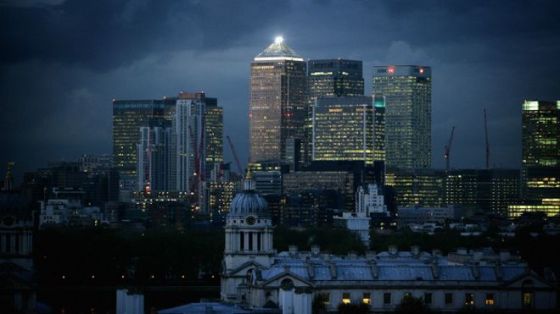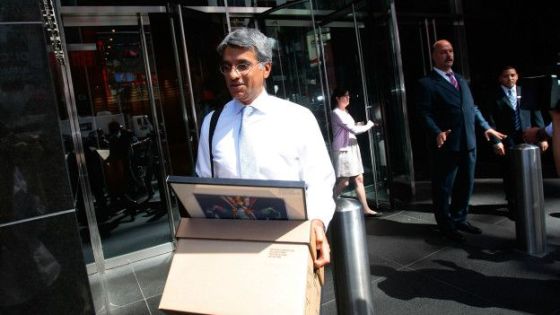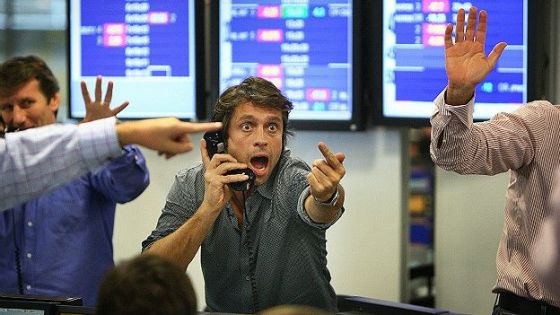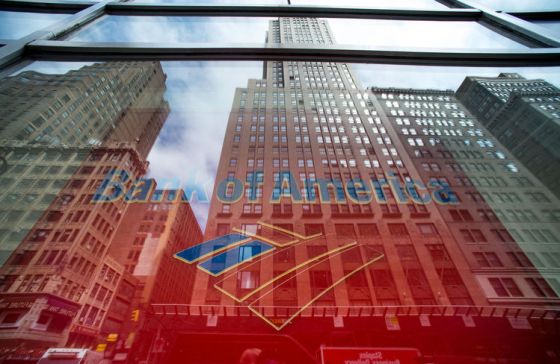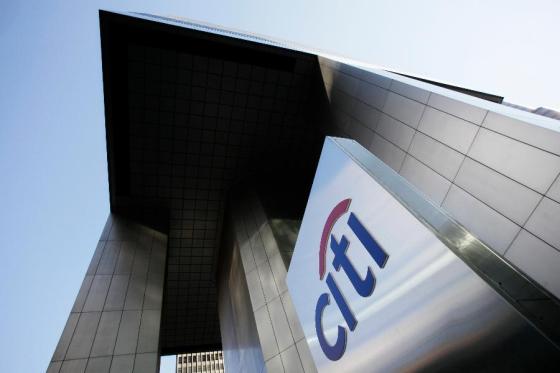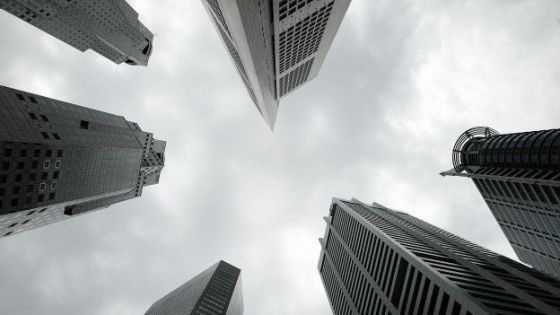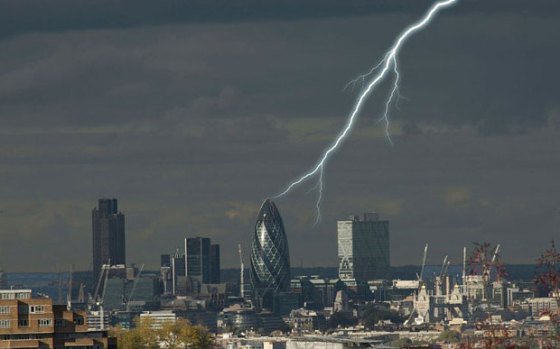HOW TO WORK 28 BANKS DOMINATE THE GLOBAL ECONOMY
The financial implosion of 2008 and the great global recession changed little and nothing at the scene of the world economy.
Almost eight years of the crisis and amid a global stagnation, the world still dominated by 28 large international banks (see what the end of this note), called by some of his staunchest critics as "the world 's hydra" .
These entities manage large global economic variables, impose conditions on democratic governments and in search of quick and stratospheric profits, betting on an increasingly dizzying roulette that can flare up again at any time.
François Morin, author of the recently published "Global hydra, the banking oligopoly" is professor emeritus of economics at the University of Toulouse and former member of the general council of the Bank of France.
"The big banks held toxic products responsible for the crisis but rather to restructure the banks, States ended assuming their duties and private debt was transformed into public debt , " says Morin.
French researcher puts the focus on five mechanisms that allow this financial, economic and political hegemony:
1. Assets (property, money, customers, loans, etc)
The 28 banks hold higher than public debt of 200 states of the world resources.
While these entities have assets of US $ 50,341 billion, global public debt amounts to US $ 48,957 billion.
Another way to size it: there are hundreds of thousands of banks worldwide, but these 28 companies account for 90% of financial assets.
In this scenario hyperconcentration, the fall of one or more of these banks have a devastating potential not only on the financial sector but on the economy in general.
It is the basis of the argument in the center of the post 2008 debates: the risk of institutions "too big to fail" (so large that can not be allowed to go bankrupt)
According to Oscar Ugarteche, an economist at the UNAM of Mexico and author of "The great change" , which studies this new global financial system, with this level of concentration of financial power there is "every chance" repetition of a crisis like that of 2007 -2008.
"These markets grew with the financial liberalization of the past 30 years, which allowed them to leave their place of financial intermediary with production and consumption, ie transmission belt for productive projects and purchases" , said the BBC.
"By participating in speculative markets from foreign exchange and interest rates to commodities and derivatives, with an explosive growth of its credit will finance this expansion, reached 2008 , " he added.
"The situation has not changed and today we are seeing that many of these banks are in serious trouble."
2. Creating Currency
The classic system of monetary issue is that of a Mint that prints the tickets that need a Central Bank located in the center of the financial scene.
But today 90% of money is created by these 28 banks: only 10% is the responsibility of central banks.
The passage of physical money to credit money is changing this equation.
"We are closing the circle. Initially, there were banks that made operations of foreign and domestic trade.It was money-credit. But there was no control and centralization of this function " , explained Ugarteche.
"This only begins to happen with the creation of a central bank responsible for monetary issue. The first is that of England in the seventeenth century. But with the banking deregulation of the 90 we are back to the beginning. The banks issue credit and there is a lot of control about it, " he said.
If before the expansion of money kept some proportion to the level of monetary reserves of a country today that limit has lost relevance.
In this context total credit easing, the Global Consultant McKinsey estimates that the total-that debt, the sum of public, private and individual debt - grew by more than US $ 57 billion in the last seven years and today slashing US $ 200 billion , about three times the world GDP.
3. Operation exchange market
The foreign exchange market is one of the largest in the world: US $ 6,000 million a day.
Five of the 28 banks control 51% of that market.
"The exchange rate is managed in the United States and the United Kingdom, that is, not only depends on economic variables of a country" , Ugarteche said.
"Enough with these operators, linked to the banks of these nations decide the value of a currency does not hold for the attack speculatively through the futures market" , said the expert.
"With massive purchases or sales dragged the rest of the actors causing a change in the exchange rate that has nothing to do with the economic health of a country."
The Brazilian case illustrates this phenomenon.
In September 2014 Brazil had a high level of reserves, the highest at a regional level insufficient to contain the attack on the currency.
The government adopted a series of measures such as raising interest rates to stimulate the inflow of foreign currency and prevent capital flight, but these measures drowned the credit he needed the productive and led to the current deep recession.
"It was an induced crisis. And it is not an isolated case. In Mexico the value of the currency went from 14-20 without mediate a large fiscal deficit, a crisis of balance of payments or inflation, falling reserves or economic activity " , Ugarteche said.
4. Managing interest rates
With its financial potential, these 28 institutions have a fundamental gravitation on interest rates.
Given the stratospheric level of daily circulation of financial assets and debt, any change in the interest rate automatically moves huge amounts of money.
The research began in 2012 United States, Britain and the European Commission showed how this level of concentration of banks ends in market manipulation.
According to research, 11 of 28 (Bank of America, BNP-Paribas, Barclays, Citigroup, Credit Suisse, Deutsche Bank, Goldman Sachs, HSBC, JP Morgan Chase, Royal Bank of Scotland, UBS) acted as "entities or bands organized " to manipulate Libor interest rates.
Libor remembers the day in the London market determines the rate at which banks lend and has a direct impact on the derivatives market and what consumers and producers pay for their loans.
"Things have not changed. A similar scandal happened recently with Goldman Sachs, Morgan Stanley and JP Morgan in the commodities market " , said Ugarteche.
5. Derivatives
Half of the 28 banks produced by US $ 710,000 arising million, ie the equivalent of ten times the gross domestic product worldwide.
In his book "The great change" , Ugarteche illustrates the operation of the derivatives market with the case of a modest financial asset: a cow.
What can be done if we want to make cash cow?
At other times it was sold in exchange for a certain amount of cash.
But today you can sell their future value.
As it is not a present but future transaction, the value is multiplied many times. For example:
He sells the likely future income from milk cow
He sells the cow give birth to calves
He eventually sold the milk of these likely calves, or cheese and butter they produce.
"From a real cow, a fictitious economy built using various financial transactions is created. It is a world of probabilities. The calf is a possible future, nothing more than that. The same performance of a cow.What if the cow is sick? " , Ugarteche said.
In this case, the operations carried out go for a black hole.
Thus, in 2008 they disappeared, more than US $ 200,000 million, which dragged in its fall insurers that supposedly guaranteed all this flow of financial value.
Nothing has changed.
The 28 largest banks
JP Morgan Chase
Bank of America
Citigroup
HSBC
Deutsches Bank
Groupe Crédit Agricole
BNP Paribas
Barclays PLC
Mitsubishi Ufjfg
Bank of China
Royal Bank of Scotland
Morgan Stanley
Goldman Sachs
Mizuho FG
Santander
Societe Generale
ING Bank
BPCE
Wells Fargo
Sumitomo Mitsui FG
UBS
Unicredit Group
Credit Suisse
Nordea
BBVA
Standart Chartered
Bank of New York Mekon
State Street
The total balance of these banks is US $ 50,341 million.
The financial implosion of 2008 and the great global recession changed little and nothing at the scene of the world economy.
Almost eight years of the crisis and amid a global stagnation, the world still dominated by 28 large international banks (see what the end of this note), called by some of his staunchest critics as "the world 's hydra" .
These entities manage large global economic variables, impose conditions on democratic governments and in search of quick and stratospheric profits, betting on an increasingly dizzying roulette that can flare up again at any time.
François Morin, author of the recently published "Global hydra, the banking oligopoly" is professor emeritus of economics at the University of Toulouse and former member of the general council of the Bank of France.
"The big banks held toxic products responsible for the crisis but rather to restructure the banks, States ended assuming their duties and private debt was transformed into public debt , " says Morin.
French researcher puts the focus on five mechanisms that allow this financial, economic and political hegemony:
1. Assets (property, money, customers, loans, etc)
The 28 banks hold higher than public debt of 200 states of the world resources.
While these entities have assets of US $ 50,341 billion, global public debt amounts to US $ 48,957 billion.
Another way to size it: there are hundreds of thousands of banks worldwide, but these 28 companies account for 90% of financial assets.
In this scenario hyperconcentration, the fall of one or more of these banks have a devastating potential not only on the financial sector but on the economy in general.
It is the basis of the argument in the center of the post 2008 debates: the risk of institutions "too big to fail" (so large that can not be allowed to go bankrupt)
According to Oscar Ugarteche, an economist at the UNAM of Mexico and author of "The great change" , which studies this new global financial system, with this level of concentration of financial power there is "every chance" repetition of a crisis like that of 2007 -2008.
"These markets grew with the financial liberalization of the past 30 years, which allowed them to leave their place of financial intermediary with production and consumption, ie transmission belt for productive projects and purchases" , said the BBC.
"By participating in speculative markets from foreign exchange and interest rates to commodities and derivatives, with an explosive growth of its credit will finance this expansion, reached 2008 , " he added.
"The situation has not changed and today we are seeing that many of these banks are in serious trouble."
2. Creating Currency
The classic system of monetary issue is that of a Mint that prints the tickets that need a Central Bank located in the center of the financial scene.
But today 90% of money is created by these 28 banks: only 10% is the responsibility of central banks.
The passage of physical money to credit money is changing this equation.
"We are closing the circle. Initially, there were banks that made operations of foreign and domestic trade.It was money-credit. But there was no control and centralization of this function " , explained Ugarteche.
"This only begins to happen with the creation of a central bank responsible for monetary issue. The first is that of England in the seventeenth century. But with the banking deregulation of the 90 we are back to the beginning. The banks issue credit and there is a lot of control about it, " he said.
If before the expansion of money kept some proportion to the level of monetary reserves of a country today that limit has lost relevance.
In this context total credit easing, the Global Consultant McKinsey estimates that the total-that debt, the sum of public, private and individual debt - grew by more than US $ 57 billion in the last seven years and today slashing US $ 200 billion , about three times the world GDP.
3. Operation exchange market
The foreign exchange market is one of the largest in the world: US $ 6,000 million a day.
Five of the 28 banks control 51% of that market.
"The exchange rate is managed in the United States and the United Kingdom, that is, not only depends on economic variables of a country" , Ugarteche said.
"Enough with these operators, linked to the banks of these nations decide the value of a currency does not hold for the attack speculatively through the futures market" , said the expert.
"With massive purchases or sales dragged the rest of the actors causing a change in the exchange rate that has nothing to do with the economic health of a country."
The Brazilian case illustrates this phenomenon.
In September 2014 Brazil had a high level of reserves, the highest at a regional level insufficient to contain the attack on the currency.
The government adopted a series of measures such as raising interest rates to stimulate the inflow of foreign currency and prevent capital flight, but these measures drowned the credit he needed the productive and led to the current deep recession.
"It was an induced crisis. And it is not an isolated case. In Mexico the value of the currency went from 14-20 without mediate a large fiscal deficit, a crisis of balance of payments or inflation, falling reserves or economic activity " , Ugarteche said.
4. Managing interest rates
With its financial potential, these 28 institutions have a fundamental gravitation on interest rates.
Given the stratospheric level of daily circulation of financial assets and debt, any change in the interest rate automatically moves huge amounts of money.
The research began in 2012 United States, Britain and the European Commission showed how this level of concentration of banks ends in market manipulation.
According to research, 11 of 28 (Bank of America, BNP-Paribas, Barclays, Citigroup, Credit Suisse, Deutsche Bank, Goldman Sachs, HSBC, JP Morgan Chase, Royal Bank of Scotland, UBS) acted as "entities or bands organized " to manipulate Libor interest rates.
Libor remembers the day in the London market determines the rate at which banks lend and has a direct impact on the derivatives market and what consumers and producers pay for their loans.
"Things have not changed. A similar scandal happened recently with Goldman Sachs, Morgan Stanley and JP Morgan in the commodities market " , said Ugarteche.
5. Derivatives
Half of the 28 banks produced by US $ 710,000 arising million, ie the equivalent of ten times the gross domestic product worldwide.
In his book "The great change" , Ugarteche illustrates the operation of the derivatives market with the case of a modest financial asset: a cow.
What can be done if we want to make cash cow?
At other times it was sold in exchange for a certain amount of cash.
But today you can sell their future value.
As it is not a present but future transaction, the value is multiplied many times. For example:
He sells the likely future income from milk cow
He sells the cow give birth to calves
He eventually sold the milk of these likely calves, or cheese and butter they produce.
"From a real cow, a fictitious economy built using various financial transactions is created. It is a world of probabilities. The calf is a possible future, nothing more than that. The same performance of a cow.What if the cow is sick? " , Ugarteche said.
In this case, the operations carried out go for a black hole.
Thus, in 2008 they disappeared, more than US $ 200,000 million, which dragged in its fall insurers that supposedly guaranteed all this flow of financial value.
Nothing has changed.
The 28 largest banks
JP Morgan Chase
Bank of America
Citigroup
HSBC
Deutsches Bank
Groupe Crédit Agricole
BNP Paribas
Barclays PLC
Mitsubishi Ufjfg
Bank of China
Royal Bank of Scotland
Morgan Stanley
Goldman Sachs
Mizuho FG
Santander
Societe Generale
ING Bank
BPCE
Wells Fargo
Sumitomo Mitsui FG
UBS
Unicredit Group
Credit Suisse
Nordea
BBVA
Standart Chartered
Bank of New York Mekon
State Street
The total balance of these banks is US $ 50,341 million.
The financial implosion of 2008 and the great global recession changed little and nothing at the scene of the world economy.
Almost eight years of the crisis and amid a global stagnation, the world still dominated by 28 large international banks (see what the end of this note), called by some of his staunchest critics as "the world 's hydra" .
These entities manage large global economic variables, impose conditions on democratic governments and in search of quick and stratospheric profits, betting on an increasingly dizzying roulette that can flare up again at any time.
François Morin, author of the recently published "Global hydra, the banking oligopoly" is professor emeritus of economics at the University of Toulouse and former member of the general council of the Bank of France.
"The big banks held toxic products responsible for the crisis but rather to restructure the banks, States ended assuming their duties and private debt was transformed into public debt , " says Morin.
French researcher puts the focus on five mechanisms that allow this financial, economic and political hegemony:
1. Assets (property, money, customers, loans, etc)
The 28 banks hold higher than public debt of 200 states of the world resources.
While these entities have assets of US $ 50,341 billion, global public debt amounts to US $ 48,957 billion.
Another way to size it: there are hundreds of thousands of banks worldwide, but these 28 companies account for 90% of financial assets.
In this scenario hyperconcentration, the fall of one or more of these banks have a devastating potential not only on the financial sector but on the economy in general.
It is the basis of the argument in the center of the post 2008 debates: the risk of institutions "too big to fail" (so large that can not be allowed to go bankrupt)
According to Oscar Ugarteche, an economist at the UNAM of Mexico and author of "The great change" , which studies this new global financial system, with this level of concentration of financial power there is "every chance" repetition of a crisis like that of 2007 -2008.
"These markets grew with the financial liberalization of the past 30 years, which allowed them to leave their place of financial intermediary with production and consumption, ie transmission belt for productive projects and purchases" , said the BBC.
"By participating in speculative markets from foreign exchange and interest rates to commodities and derivatives, with an explosive growth of its credit will finance this expansion, reached 2008 , " he added.
"The situation has not changed and today we are seeing that many of these banks are in serious trouble."
2. Creating Currency
The classic system of monetary issue is that of a Mint that prints the tickets that need a Central Bank located in the center of the financial scene.
But today 90% of money is created by these 28 banks: only 10% is the responsibility of central banks.
The passage of physical money to credit money is changing this equation.
"We are closing the circle. Initially, there were banks that made operations of foreign and domestic trade.It was money-credit. But there was no control and centralization of this function " , explained Ugarteche.
"This only begins to happen with the creation of a central bank responsible for monetary issue. The first is that of England in the seventeenth century. But with the banking deregulation of the 90 we are back to the beginning. The banks issue credit and there is a lot of control about it, " he said.
If before the expansion of money kept some proportion to the level of monetary reserves of a country today that limit has lost relevance.
In this context total credit easing, the Global Consultant McKinsey estimates that the total-that debt, the sum of public, private and individual debt - grew by more than US $ 57 billion in the last seven years and today slashing US $ 200 billion , about three times the world GDP.
3. Operation exchange market
The foreign exchange market is one of the largest in the world: US $ 6,000 million a day.
Five of the 28 banks control 51% of that market.
"The exchange rate is managed in the United States and the United Kingdom, that is, not only depends on economic variables of a country" , Ugarteche said.
"Enough with these operators, linked to the banks of these nations decide the value of a currency does not hold for the attack speculatively through the futures market" , said the expert.
"With massive purchases or sales dragged the rest of the actors causing a change in the exchange rate that has nothing to do with the economic health of a country."
The Brazilian case illustrates this phenomenon.
In September 2014 Brazil had a high level of reserves, the highest at a regional level insufficient to contain the attack on the currency.
The government adopted a series of measures such as raising interest rates to stimulate the inflow of foreign currency and prevent capital flight, but these measures drowned the credit he needed the productive and led to the current deep recession.
"It was an induced crisis. And it is not an isolated case. In Mexico the value of the currency went from 14-20 without mediate a large fiscal deficit, a crisis of balance of payments or inflation, falling reserves or economic activity " , Ugarteche said.
4. Managing interest rates
With its financial potential, these 28 institutions have a fundamental gravitation on interest rates.
Given the stratospheric level of daily circulation of financial assets and debt, any change in the interest rate automatically moves huge amounts of money.
The research began in 2012 United States, Britain and the European Commission showed how this level of concentration of banks ends in market manipulation.
According to research, 11 of 28 (Bank of America, BNP-Paribas, Barclays, Citigroup, Credit Suisse, Deutsche Bank, Goldman Sachs, HSBC, JP Morgan Chase, Royal Bank of Scotland, UBS) acted as "entities or bands organized " to manipulate Libor interest rates.
Libor remembers the day in the London market determines the rate at which banks lend and has a direct impact on the derivatives market and what consumers and producers pay for their loans.
"Things have not changed. A similar scandal happened recently with Goldman Sachs, Morgan Stanley and JP Morgan in the commodities market " , said Ugarteche.
5. Derivatives
Half of the 28 banks produced by US $ 710,000 arising million, ie the equivalent of ten times the gross domestic product worldwide.
In his book "The great change" , Ugarteche illustrates the operation of the derivatives market with the case of a modest financial asset: a cow.
What can be done if we want to make cash cow?
At other times it was sold in exchange for a certain amount of cash.
But today you can sell their future value.
As it is not a present but future transaction, the value is multiplied many times. For example:
He sells the likely future income from milk cow
He sells the cow give birth to calves
He eventually sold the milk of these likely calves, or cheese and butter they produce.
"From a real cow, a fictitious economy built using various financial transactions is created. It is a world of probabilities. The calf is a possible future, nothing more than that. The same performance of a cow.What if the cow is sick? " , Ugarteche said.
In this case, the operations carried out go for a black hole.
Thus, in 2008 they disappeared, more than US $ 200,000 million, which dragged in its fall insurers that supposedly guaranteed all this flow of financial value.
Nothing has changed.
The 28 largest banks
JP Morgan Chase
Bank of America
Citigroup
HSBC
Deutsches Bank
Groupe Crédit Agricole
BNP Paribas
Barclays PLC
Mitsubishi Ufjfg
Bank of China
Royal Bank of Scotland
Morgan Stanley
Goldman Sachs
Mizuho FG
Santander
Societe Generale
ING Bank
BPCE
Wells Fargo
Sumitomo Mitsui FG
UBS
Unicredit Group
Credit Suisse
Nordea
BBVA
Standart Chartered
Bank of New York Mekon
State Street
The total balance of these banks is US $ 50,341 million.


